Walking with Beasts
Walking with Beasts (Walking with Prehistoric Beasts in North American releases) is a 2001 six-part television documentary miniseries, produced by the BBC Natural History Unit. It is the second installment of the Walking With... series and a sequel to Walking with Dinosaurs. Beasts takes place after the extinction of the non-avian dinosaurs 65 million years ago depicted in Walking with Dinosaurs, and recreates animals of the Cenozoic with computer-generated imagery and animatronics. Like Dinosaurs, its narrative is presented in the style of a traditional nature documentary. Some of the concepts it illustrates are the evolution of whales, horses, elephants and humans.
| Walking with Beasts | |
|---|---|
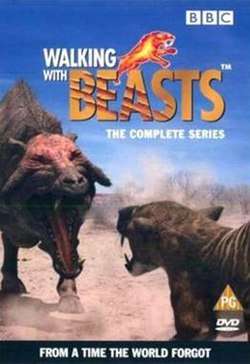 The original DVD cover of Walking with Beasts | |
| Also known as | Walking with Prehistoric Beasts |
| Genre | Documentary |
| Created by | Tim Haines Jasper James Andrew Wilks |
| Developed by | Andrew Wilks |
| Written by | Kate Bartlett Jasper James Michael Olmert Nigel Paterson |
| Directed by | Jasper James Nigel Paterson |
| Creative director(s) | Mike Milne |
| Narrated by | Kenneth Branagh (UK) Stockard Channing (US) Christian Slater (Prehistoric Planet) |
| Composer(s) | Ben Bartlett |
| Country of origin | United Kingdom |
| Original language(s) | English |
| No. of episodes | 6 |
| Production | |
| Executive producer(s) | Tim Haines |
| Producer(s) | Jasper James Nigel Paterson |
| Production location(s) | Arizona, Brazil, Ethiopia, Florida, Java, Mexico, South Africa, Yukon |
| Cinematography | John Howarth Michael Pitts |
| Editor(s) | Greg Smith Andrew Wilks |
| Running time | 30 minutes |
| Production company(s) | BBC Natural History Unit Impossible Pictures |
| Distributor | BBC Worldwide |
| Release | |
| Original network | BBC One |
| Original release | 15 November – 21 December 2001 |
| Chronology | |
| Preceded by | Walking with Dinosaurs |
| Followed by | Walking with Monsters |
| Related shows | Other shows in the Walking with... series |
| External links | |
| Website | |
In North America, Beasts was broadcast on the Discovery Channel with Stockard Channing replacing Kenneth Branagh as the narrator. It would later be re-edited and re-narrated for the second season of Prehistoric Planet for the Discovery Kids lineup, with Christian Slater providing the narration instead of Kenneth Branagh.
Production

Producer Tim Haines wanted to create a sequel to Walking with Dinosaurs so the general public could discover the fascinating mammals of the Cenozoic, which were less represented in popular culture than dinosaurs.[1]
As with Walking with Dinosaurs, the film crews would go to locations that matched the depicted time periods fairly closely and shoot either empty landscapes (when the animals would be created later with CGI) or animatronic animals for close-ups. Sometimes it was necessary to replicate the impact the animated animals would have on their environment—such as footprints left in the snow by a woolly mammoth.[2] The animatronics' broad movements were controlled by puppeteers, while their more subtle movements were remote-controlled and operated via servo motors.[3]
The visual effects budget was around 7 or 8 million dollars, much lower than a feature film of the time. Tim Haines attributed this to solid planning.[4] The fur coats and moving parts of mammals made the creatures in Beasts more challenging to animate than the scaly reptiles of Walking with Dinosaurs.[5] Short fur was animated with tricks, and long shaggy coats (like the woolly mammoth's) with fur shaders.
Live actors were used for the anatomically modern humans and Neanderthals in "Mammoth Journey".[6] In "Next of Kin", extreme close-ups of Australopithecus also employed actors wearing prosthetics.[7]
"Sabre Tooth" was shot in Brazil, where Smilodon actually roamed.[8] Filming of the ice age landscapes for the final episode took place in Canada's Yukon Territory.
List of episodes
Walking with Beasts
BBC One aired the series weekly on Thursday nights, with a regular of repeats the following Sunday afternoon. In 2010, the series was repeated on BBC Three in omnibus format, as three hour-long episodes.[9]
| No. | Title | Time | Directed by | Original air date | U.K. viewers (millions) | |
|---|---|---|---|---|---|---|
| 1 | "New Dawn"[10] | 49 mya | Jasper James & Nigel Paterson | 15 November 2001 | 13.99[11][note 1] | |
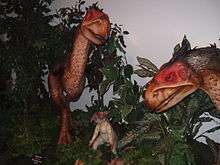 Gastornis as it appeared in Walking with Beasts The episode starts by showing how the dinosaurs were dominating the land and that mammals were small. Then it shows how "an asteroid the size of Mount Everest" struck the Earth and demolished the dinosaurs, and how mammals evolved into new forms thereafter. The first episode depicts the warm tropical world of the early Eocene, sixteen million years after the extinction of the non-avian dinosaurs. Birds, the surviving lineage of the dinosaurs, including the giant carnivorous Gastornis, rule this world, while mammals are still very small. The setting is near the Messel pit in Germany. Due to volcanic activity, sudden bulk escapes of carbon dioxide trapped underneath lakes pose a significant hazard to the local wildlife. The episode centers around a Leptictidium family, a leaping, shrew-like mammal, which has emerged in the dawn hours to forage for food. As the mother Leptictidium forages, first in solidarity, and then with her pups, she wanders near a large predatory mammal, identified as an Ambulocetus, a "walking whale". Despite its crocodilian similarity, the Ambulocetus is shown swimming by caudal undulation like a modern cetacean. A female Gastornis, who has been taking care of the single egg in her nest, makes two attempts to hunt a small herd of Propalaeotherium, early horses. The first attempt fails when sounds among the vegetation betray her presence. The second attack proves successful when the Propalaeotherium consume fermenting grapes and are unable to evade her attack. The Gastornis also defends her territory from another Gastornis. Unfortunately, while the mother hunts, a horde of Titanomyrma, giant carnivorous ants, encounter the egg when it was just starting to hatch, and successfully kill and eat the chick. When the female discovers her dead offspring at dusk she leaves the forest to try and start another family. With the arrival of night, a band of lemur-like Godinotia, socialize and copulate in the dark. Ambulocetus finally manages to catch a creodont near the lake edge. As the night wears on, an earth tremor unleashes trapped carbon dioxide out from underneath the lake and the gas suffocates most of the surrounding life. The Leptictidium survive because the nest was upwind of the gas, and Gastornis also survived because she left that area in the forest. It is mentioned that although the Leptictidium survived the gas, they would ultimately leave no descendants, while the Ambulocetus, who was killed by the lethal gases, would evolve into the whales, hereby setting the scene for the next episode. Animals: Leptictidium · Gastornis · Ambulocetus · Propalaeotherium [note 2] · Godinotia · Eurotamandua (unnamed, live-acted by a tamandua) · Titanomyrma (unnamed, identified as giant ants) · Lesmesodon (unnamed) · Crocodile · Gecko · Tyrannosaurus (stock footage from Walking with Dinosaurs) · Ankylosaurus (stock footage from Walking with Dinosaurs) · Didelphodon (stock footage from Walking with Dinosaurs) | ||||||
| 2 | "Whale Killer" | 36 mya | Jasper James & Nigel Paterson | 22 November 2001 | 11.34 | |
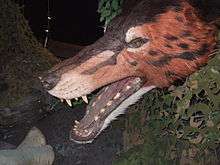 Andrewsarchus as it appeared in Walking with Beasts The second episode is set in late Eocene, when the polar caps froze over and drastically changed the Earth's ocean currents and climate. The first part of the episode explains how an early whale, Basilosaurus mates and how the world is changing into an ocean famine. On land there is an Andrewsarchus driven to the beach to feed on sea turtles. The narrator explains that Andrewsarchus, the largest land mammal predator ever to walk the earth, has hooves and is related to sheep, so it is, in a sense, a "sheep in wolf's clothing". Back in the ocean, a starving mother Basilosaurus is forced to hunt in the mangrove swamps of Africa, which will later become the Sahara Desert. Unable to catch a primate called Apidium due to a shark killing one of the primates and spooking the others, she is then hunting a lone Moeritherium. The Moeritherium crawls on to land, but in the mangroves, land does not last long. However the Moeritherium escapes and the Basilosaurus returns to the sea. The cast moves on to land where a herd of Embolotherium struggle to survive: one of their calves dies after birth and two Andrewsarchus feast on it, but the mother Embolotherium drives them away because she has a strong bond with her offspring, even if it is dead. Back in the sea, the mother Basilosaurus preys on a group of Dolphin-like Dorudon and their young, and is successful. The episode ends with the mother Basilosaurus swimming with her newborn calf. It is acknowledged in the end that soon Africa will be pulled closer to Europe, causing the Tethys Sea to disappear. While whales as a whole will survive the ensuing extinction, Basilosaurus, unfortunately, will disappear with the Tethys as well. Animals: Basilosaurus · Andrewsarchus · Embolotherium (identified as brontothere) · Dorudon · Moeritherium · Apidium · Physogaleus (identified as shark) · Puppigerus (identified as turtle) · Vulture | ||||||
| 3 | "Land of Giants" | 25 mya | Jasper James & Nigel Paterson | 29 November 2001 | 9.27 | |
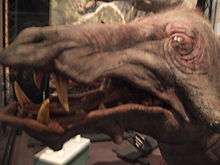 Entelodon as it appeared in Walking with Beasts The third episode takes place during the late Oligocene, in Mongolia, where there were seasonal rains followed by a long drought. It focuses on a mother Paraceratherium, a massive hornless rhinoceros, the largest land mammal to ever live as one night, she gives birth to a healthy male calf, while trying to fend off the predatory Hyaenodon. By morning, the calf slowly learns how to walk and after a week, his mother takes him out to the open plain where he will spend the rest of his life. The inquisitive calf runs into a mother Cynodictis, who drives him out of her family burrow to protect her pups. The calf then learns to survive on his own, by copying his mother's actions. Not long after, his mother's previous calf arrives, but the mother violently repels him. A Hyaenodon is then seen stalking a herd of Chalicotherium, successfully killing one, but a trio of Entelodon drive it off the carcass. During the dry season, there is a huge shortage of food and water, putting even the hardiest to their greatest stress. The mother, now dehydrated, has not been able to produce enough milk for the calf, who's getting weaker and weaker as time progresses. At night, the pair are joined by an older female, who leads them to a small, muddy lake, where they drink their fill and gain back their strength. The wet season returns, the water levels rise, flooding the Cynodictis family burrow, and drowning the sleeping pups. The mother and calf have to cross a river, the mother making it with ease, while the calf struggled to make it up a muddy bank, but he finally succeeded. 3 years pass, and the calf is furiously chased away by his mother. He then was not seen for days, but when he was seen, he was limping and had a leg injury, possibly caused by another young male Paraceratherium. When he returned to his mother, she aggressively chased him away, as she now has a new calf to nurture. After 3 months, the calf learns how to stand on his own two feet and successfully drives away an Entelodon. Animals: Paraceratherium (identified as indricothere) · Hyaenodon · Entelodon · Chalicotherium (identified as chalicothere) · Cynodictis (identified as bear-dog)[12] | ||||||
| 4 | "Next of Kin" | 3.2 mya | Jasper James & Nigel Paterson | 6 December 2001 | - [note 3] | |
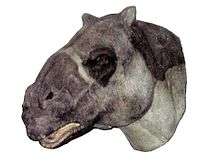 Ancylotherium as it appeared in Walking with Beasts The fourth episode takes place in the Great Rift Valley in northeastern Africa of the late Pliocene. The climate has changed, and now great grasslands have replaced trees, with many modern-day animals appearing with them. The episode focuses around a tribe of small hominids known as Australopithecus, one of the first apes able to walk upright and a close ancestor to humans. The Australopithecus has evolved to walk upright so as to better manoeuvre the plains as well as the climb the trees. However, it notes that although the Australopithecus looks human, it still only has a brain the size of a chimpanzee's. Some of the topics explored in the episode are the close social bonds among the tribe, how they use grooming as a means of communication, and how they work together to forage for food and to defend one another from attacks from such animals as an angry male Deinotherium, an ancestor of the modern elephant which they have to run from to avoid being crushed, and the feline predator Dinofelis. It touches upon how competing tribes of Australopithecus war among one another, although most of the fighting is for show. It also explains the hierarchy in the tribe among the males, who are much larger than the females, and tells a story of how the dominating male nicknamed Grey is eventually overcome by another male nicknamed Hercules, who wins the right to feed first at a carrion and to mate with the females. The main story tells of a young Australopithecus nicknamed Blue whose mother has been killed by malaria. He and his tribe are later forced to flee their homeland during a fight over a waterhole with a rival tribe. After a long journey in search of a new home, Blue fits into his tribe by rallying them into scaring off a hungry Dinofelis. Animals: Australopithecus · Dinofelis · Deinotherium · Ancylotherium · Common warthog · White rhinoceros · Black-backed jackal · White-backed vulture · Zebra (carcass) · Ostrich (egg) | ||||||
| 5 | "Sabre Tooth" | 1 mya | Jasper James & Nigel Paterson | 13 December 2001 | 5.87 | |
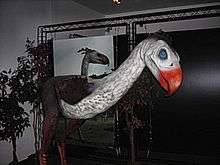 Phorusrhacos as it appeared in Walking with Beasts The fifth episode shows the strange fauna of the isolated continent of South America and explores the effects of the Great American Interchange, which had happened 1.5 million years earlier. Since South America had drifted apart from Antarctica 30 million years ago, many unique mammals had evolved, including the Doedicurus, an armoured armadillo-like mammal with a cannon ball-sized spiked club on its tail; the Macrauchenia, a camel-like mammal with a long trunk; and the Megatherium, a giant ground sloth. Before the continents of South America and North America collided, a 10-foot-tall predatory terror bird called Phorusrhacos, had reigned as top predator. However, the great cats migrating from the north, soon displaced them as top predators. The episode focuses on a male Smilodon, a sabre-toothed cat, called Half Tooth, whose leadership of a pride is threatened by two rival males who are brothers and work together against him. Half Tooth wisely backs off without any serious injuries, feeling that the rival males would be too strong for him. The rival males kill Half Tooth's cubs, and take over his pride. Next, the episode shows the Smilodon hunting down Macrauchenia and trying to protect the remaining two young from the two males. In the background, Phorusrhacos wait to scavenge the Macrauchenia, which the pride of Smilodon have killed. However, a Megatherium charges the Smilodon, in order to eat some of the carrion as a diet supplement. In the process, the Megatherium kills the dominant rival male, enabling Half Tooth to return, kill the other male and reclaim his territory. A year later, his mate has another litter of cubs. Animals: Smilodon · Phorusrhacos · Macrauchenia · Megatherium · Doedicurus | ||||||
| 6 | "Mammoth Journey" | 30,000 ya | Jasper James & Nigel Paterson | 20 December 2001 | 9.48 | |
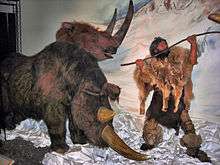 Woolly rhinoceros as it appeared in Walking with Beasts The sixth episode takes place during the last Ice Age of the late Pleistocene. It starts in the peak of the summer. The North Sea has become a grassy plain because the ice at the polar caps has caused the sea levels to drop significantly. Grazing on the plain are herds of woolly mammoths, saiga antelopes, and bison. A clan of Cro-Magnon is also there spending the summer. The central focus of the episode is the migration of the herd of mammoths as they travel 400 kilometres from the North Sea to the Swiss Alps for the winter and then back again in the spring. As the mammoth herd migrates south, the episode shows two large deer, the elk-like Megaloceros, fighting for rights to a harem of females. As the male elk fight, a group of Cro-Magnons ambushes them and kills one. A mother mammoth and her baby are separated from the herd, but survive an encounter with a European cave lion. When the herd of mammoths reaches the Swiss Alps, the mother and baby mammoth reunite with their herd. The episode also depicts a clan of Neanderthals, who have especially evolved to survive in the cold climate. One is charged by a woolly rhinoceros, but escapes, in part because of his stocky constitution. The climax of the episode is when the clan of Neanderthals attack the herd of mammoth as they turn back to the north. The Neanderthals are gifted hunters who are able to chase two mammoths off a cliff by using fire and spears, one of them being the matriarch of the herd. The episode ends in the Oxford University Museum of Natural History with people looking at various skeletons of some descendants of the animals featured in the series. The camera then pulls back through the roof of the museum until the whole world is visible. The narrator states that, "We have since built museums to celebrate the past, and spent decades studying prehistoric lives. And if all this has taught us anything, it is this: no species lasts forever." Animals: Woolly Mammoth · Megaloceros · Woolly Rhinoceros · European early modern humans (identified as humans) · Cave lion · Neanderthal · Saiga antelope · Wolf · Wisent | ||||||
The Science of Walking with Beasts
A two-episode companion documentary, The Science of Walking with Beasts, aired in November 2001 on BBC One. This series featured interviews with palaeontologists and explanations of how the fossil record and modern day descendants have informed what is known about the animals depicted in Beasts, as well as brief sections showing the development of the CGI and animatronic animals used in the series.
| No. | Title | Directed by | Original air date | |
|---|---|---|---|---|
| 1 | "Triumph of the Beasts" | Kate Bartlett | 21 November 2001 | |
| An explanation of how mammals evolved to be larger and more prevalent, eventually taking the dinosaurs' place as some of the most successful creatures on the planet. The Messel pit fossil site and fossil discoveries of Roy Chapman Andrews are featured. | ||||
| 2 | "The Beasts Within" | Nigel Paterson | 28 November 2001 | |
| An explanation of how prehistoric apes evolved into modern man, and which attributes made human ancestors so successful. The La Cotte de St Brelade site is featured. | ||||
Release
Walking with Beasts was originally broadcast in the United Kingdom on the BBC1 from 12 November to 21 December 2001. In North America, it aired on December 9, 2001 on the Discovery Channel. The UK broadcast was the first non-sports BBC interactive programme.[13] Beasts was released on VHS on 26 November 2001. A DVD release came the next year on 12 February for North America (as Walking with Prehistoric Beasts) and 8 April in the United Kingdom. The North American release restores the original narration by Kenneth Branagh. The DVD contains several special features: two 50-minute documentaries on prehistoric life, "Triumph of the Beasts" (about Cenozoic life at large) and "The Beasts Within" (which focuses on the humans and primates in the show); interviews with Tim Haines; animated storyboards; a photo gallery; and several fact files on the animals featured in the series. This edition was bundled with The Complete Walking with... Collection which came out on 23 July 2002.
A re-edited and re-narrated version of Beasts was presented as the second season of Prehistoric Planet, a Discovery Kids programme intended for a younger audience than Walking with...
Promotion
Beasts was promoted with a breakfast cereal tie-in from Kellogg's and the video game Walking with Beasts: Operation Salvage for Windows PCs.[14] The soundtrack by Ben Bartlett was released on CD. An exhibition took place at the Herbert Art Gallery and Museum.[15]
Reception
The first episode of Walking with Beasts attracted an audience of 8.5 million, 35 per cent of television viewers at that time.[16]
Critics generally enjoyed Walking with Beasts.[17] However, there were some complaints about overbearing narration and disappointing visual effects.[18]
Companion book
A companion book was written by Tim Haines to accompany the first screening of the series in 2001. As with Walking with Dinosaurs, the written version of Walking with Beasts elaborated on the background for each story, went further in explaining the science on which much of the programme as based, and included descriptions of several animals not identified or featured in the series.[19]
Scientific accuracy
In the first episode, the Gastornis are depicted as carnivorous predators, which is in agreement with their perception at the time as "terror birds." However, in 2013, a scientific study suggested that the bird was probably omnivorous or a herbivore.[20] Ambulocetus is depicted as amphibious; later studies suggest that it was fully aquatic.[21] Ambulocetus lived in Pakistan, not Germany.[22]
Awards
The series won an Emmy Award for Outstanding Animated Program.
Notes
- 7 day data, including the original Thursday broadcast and Sunday repeat for the six main episodes.
- Specimen featured in episode was based on Propaleotherium parvulum which is now considered to be synonymous with Eurohippus
- This episode did not reach the Top 30 programmes.
References
- Tim Haines (2002). Tim Haines Production Interview (DVD featurette). BBC.
- "Making Of - TV Production". bbc.co.uk. 2001. Archived from the original on 23 December 2001.
- "Making Of - Animatronics". bbc.co.uk. 2001. Archived from the original on 21 December 2001.
- Tim Haines (2002). Tim Haines Production Interview (DVD featurette). BBC.
The budget for this was between seven and eight million, but in terms of what we were trying to do, that is bargain basement. To give you some idea, when you see films like Jurassic Park ... they have effects budgets that run into many tens of millions of pounds. They have to, that's what they're selling. Seven to eight million for what is massively more effects shots and effects material is very, very cheap. But that's because we know exactly what we're doing and what we want from those effects and we're very targeted in our approach. We don't waste any effects at all.
- "Making Of - Computer Graphics". bbc.co.uk. 2001. Archived from the original on 21 December 2001.
- "The Beasts Within" (DVD featurette). BBC. 2002.
- Tim Haines (2002). Production Interviews (DVD featurette). BBC.
- "Making Of - Model Making". bbc.co.uk. 2001. Archived from the original on 14 December 2001.
- Walking with Beasts - Compilations - Episode 1 bbc.co.uk. Web. Retrieved 19 September 2018.
- Walking with Beasts - New Dawn bbc.co.uk. Web. Retrieved 19 September 2018.
- "Weekly top 30 programmes". BARB. Retrieved 19 September 2018.
- Haines, Tim (2006). The Complete Guide to Prehistoric Life. Canada: Firefly Books. p. 176. ISBN 1-55407-125-9.
- Gibson, Owen (9 October 2001). "Digital Evolution for BBC Beasts". The Guardian.
- "65 Million Years of Strategy". IGN. 5 October 2001.
- "Winner of competition for Walking with Beasts exhibition at Coventry's The Herbert". Coventry Telegraph. 23 October 2001.
- Mills, Dominic (27 November 2001). "Munching with Beasts". The Telegraph.
- Zad, Martie (9 December 2001). "Walking with Prehistoric Beasts". The Washington Post. Archived from the original on 11 September 2016. – via HighBeam Research (subscription required)
- "First night: walking with beasts". The Guardian.
- Haines, Tim (2001). Walking with Beasts: A Prehistoric Safari. DK Publishing. ISBN 0789478293.
- Viegas, Jennifer (30 August 2013). "'Terror bird' was scary-looking vegetarian". ABC Science. Retrieved 9 February 2016. Italic or bold markup not allowed in:
|publisher=(help) - Ando, K.; Fujiwara, S.-I. (2016). "Farewell to life on land – thoracic strength as a new indicator to determine paleoecology in secondary aquatic mammals". Journal of Anatomy. 229 (6): 768–777. doi:10.1111/joa.12518.
- Paleotology database. "H-GSP 9210 (Eocene of Pakistan)".
External links
| Wikiquote has quotations related to: Walking with Beasts |
- Walking with Beasts at BBC Programmes

- Walking with Beasts - BBC Science & Nature
- Walking with Prehistoric Beasts on IMDb
- Walking with Beasts at ABC